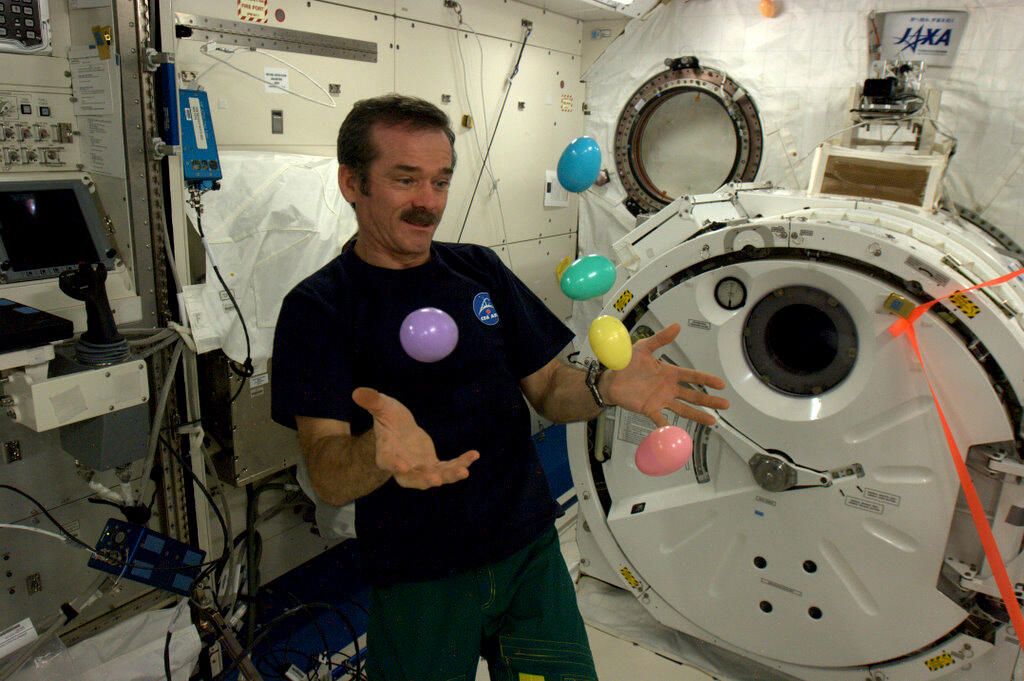
Possibly one of the most defining aspects of space is the sensation of free fall. Of course, gravity exists in space, the same as it does everywhere else in the universe (probably), but in space we feel its effects differently because we aren’t close enough to a body of sufficient mass to feel a strong pull. That, and our spaceship itself is also in free fall, so if that’s our frame of reference we feel no weight because there’s nothing for weight to push back on … but that’s a concept probably best left for O is for Orbit.
The thing is, as fun as weightlessness can be, in the long-term it can have some negative health effects, such as deterioration of bone and muscles, weakening of the immune system, etc. The effects of micro gravity on human fertility are not very well-studied, but there’s some speculation that conception and gestation would be impossible, since embryos need gravity in order to implant properly. Humans are adapted to live on the surface of Earth, and that means living with a constant 10 m/s2 or so of gravitational acceleration.
For future space colonies and spacefaring civilizations, this means we need to find a way to simulate the effects of gravity in a micro-gravity environment. There are a few common ways to deal with this problem:
- Artificial Gravity — Applied phlebotinum that creates a field within which the gravity is normal. A necessary weasel hand wave that you’ll see most often in soft sci-fi and space opera, where the plot and characters are more important than the science.
- Centrifugal Gravity — The illusion of gravity created by spinning a can-like spaceship or space station in a circle, pressing the humans against the inside wall. You’ll see this in both hard and soft sci-fi. Scale it up, and you get Ringworld Planets.
- Powerful Starship Drive — If your starship drive is powerful enough, it can accelerate you at 10 m/s2, effectively creating the sensation of gravity. Your starship will be like a flying skyscraper, where “down” is in the direction of the engines. At this rate of acceleration, you should reach 99.9% the speed of light in about a year, which opens up all sorts of possibilities for relativistic space travel (provided you have a sufficiently massive energy source to sustain that reaction). Just be sure to give yourself the same amount of time to decelerate, otherwise bad things may happen.
- Baby Planet — An asteroid no larger than a small asteroid that still, for some reason, has normal Earth-like gravity. Think Le Petit Prince. Not nearly as common as the other three, but the existence of gravitational waves means that it may be possible (or at least plausible) to create gravity generators that work this way.
- Roll with it — Yeah, so everything is weightless in space. So what? Deal.
Another problem related to gravity is rapid deceleration. Unless you don’t mind splattering everyone in your starship all over the walls and ceilings, you can’t go from zero to near-light speeds (or vice versa) without some way to counteract the sharp change in momentum. Space opera and soft sci-fi gets around this by using inertial dampers–basically, magical devices that give the starship a nice, soft ride (unless you want the bridge to explode, of course). As you might expect, stories on the harder side of sci-fi tend to play around with this a lot more.
My first exposure to artificial gravity came when I read a comic book version of The Norby Chronicles by Isaac Asimov. The characters had a device that would basically allow them to levitate, and I thought that was so cool. It wasn’t until I read the Corellia Trilogy by Roger Allen McBride that I realized that every starship in the Star Wars universe had a machine that could manipulate gravity like this. At one point, the artificial gravity generators on one of the ships failed. My mind was blown, and I’ve never looked at gravity the same since.
I tend to write stories where the characters and plot are more central than the science, so I’ll often just fall back on the standard artificial gravity field like most space opera. During combat maneuvers, though, things get a bit more tricky, with dampers on the bridge that mitigate (but don’t erase) the worst effects of rapid deceleration, and special coffin-like chambers for the crew below decks to keep them from getting splattered. In my Star Wanderers series, I also use centrifugal gravity for the larger space stations, since I figure the energy costs of artificial gravity tend to scale up.
In short, science fiction stories that address the problem of gravity in a real and thoughtful way tend to be a lot more believable and immersive, even if the solution to the problem is basically magic. As with anything in science fiction, there are so many imaginative ways of dealing with the problem that it’s actually more of an opportunity than anything else.

I knew about the hand wavying type of artifical gravity, and the centrifugal one, but I didn’t even think of acceleration. Fascinating topic.
Rinelle Grey